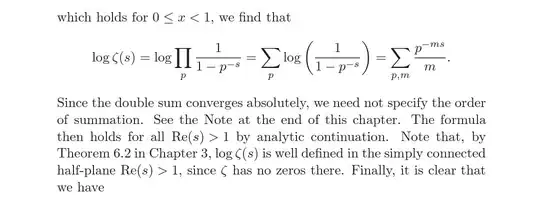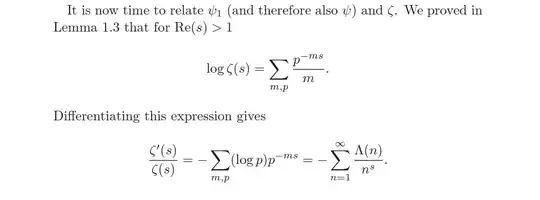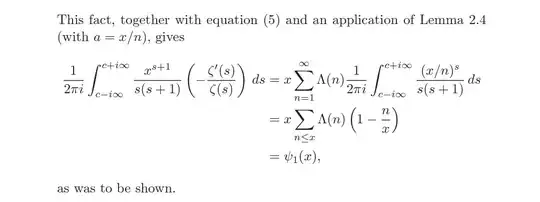- Let $s \in \mathbb{C}$ with $\mathrm{Re}(s)>1$, and let $c>1$ such that $\mathrm{Re}(s)>c$. Notice that
\begin{align*}
\left| \sum_{\substack{p \text{ prime} \\ m \geq 1}} \frac{p^{-ms}}{m} \right| &=\left| \sum_{\substack{p \text{ prime} \\ m \geq 1}} \frac{1}{p^{ms}m} \right| \\ &\leq \sum_{\substack{p \text{ prime} \\ m \geq 1}} \left|\frac{1}{p^{ms}m} \right| \\
& = \sum_{\substack{p \text{ prime} \\ m \geq 1}} \frac{1}{p^{\mathrm{Re}(ms)}m} \\
& \underbrace{\leq }_{\mathrm{Re}(s)>c} \sum_{\substack{p \text{ prime} \\ m \geq 1}} \frac{1}{p^{mc}m}.
\end{align*}
Now, since the $k^{\text{th}}$ prime is greater than $k$
$$\sum_{\substack{p \text{ prime} \\ m \geq 1}} \frac{1}{p^{mc}m} \leq \sum_{\substack{k \geq 2 \\ m \geq 1}} \frac{1}{k^{mc}m} \leq \sum_{\substack{k \geq 2 \\ m \geq 1}} \frac{1}{k^{mc}}.$$
Finally,
\begin{align*}
\sum_{\substack{k \geq 2 \\ m \geq 1}} \frac{1}{k^{mc}} &=\sum_{k \geq 2} \left( \frac{1}{1-\frac{1}{k^{c}}}-1 \right) \\
&=\sum_{k \geq 2} \frac{1}{k^{c}-1} \\
&<\infty.
\end{align*}
By the Weierstrass $M$-test, this computation implies that $\sum \frac{p^{-ms}}{m}$ converges uniformly when $\mathrm{Re}(s)>1$.
Since the uniform limit of holomorphic functions is holomorphic, the previous step implies that $\log(\zeta(s))$ is holomorphic for $\mathrm{Re}(s)>1$. Then you can differentiate the series of $\log(s)$ term by term to obtain
$$ \frac{\zeta'(s)}{\zeta(s)}=\frac{d}{ds} \log(\zeta(s))=\sum_{m,p} \frac{d}{ds}\frac{p^{-ms}}{m}=-\sum_{m,p} (\log p) p^{-ms}.$$
The equality $-\sum_{m,p} (\log p) p^{-ms}=-\sum_{n=1}^{\infty} \frac{\Lambda(n)}{n^{s}}$ comes from the definition of the Von Mangoldt function:
$$\Lambda(n)=\begin{cases} \log p & \text{if }n=p^{m}, \\ 0 & \text{otherwise} \end{cases}.$$
Thus
$$\sum_{n=1}^{\infty} \frac{\Lambda(n)}{n^{s}}=\sum_{\substack{p \text{ prime} \\ m \geq 1}} \frac{\log p}{p^{ms}}.$$
I will show that $\sum_{n=1}^{\infty} \frac{\Lambda(n)}{n^{s}}$ converges uniformly using the Weiestrass $M$-test. As before, take $s$ with $\mathrm{Re}(s)>1$, and let $c>1$ such that $\mathrm{Re}(s)>c$. By definition of the Von Mangoldt function you have the following bound
\begin{align*}
\left| \sum_{n=1}^{\infty} \frac{\Lambda(n)}{n^{s}} \right| &\leq \sum_{n=1}^{\infty} \left| \frac{\Lambda(n)}{n^{s}} \right| \\
& =\sum_{n=1}^{\infty} \frac{\Lambda(n)}{n^{\mathrm{Re}(s)}} \\
& \leq \sum_{n=1}^{\infty} \frac{\log(n)}{n^{c}}.
\end{align*}
Since for any $A>0$ we have $\log(n)<\frac{n^{A}}{A}$, we obtain that
$$ \sum_{n=1}^{\infty} \frac{\log(n)}{n^{c}} \leq \frac{1}{A} \sum_{n=1}^{\infty} \frac{1}{n^{c-A}}.$$
If you choose $A$ such that $c-A>1$ (which exists because $c>1$), then you obtain that the RHS of this inequality is finite. So, in virtue of the Weiestrass $M$-test the series of holomorphic functions $\sum_{n=1}^{\infty} \frac{\Lambda(n)}{n^{s}}$ is uniformly convergent. This kind of convergence allow you to change the integral with the series.


